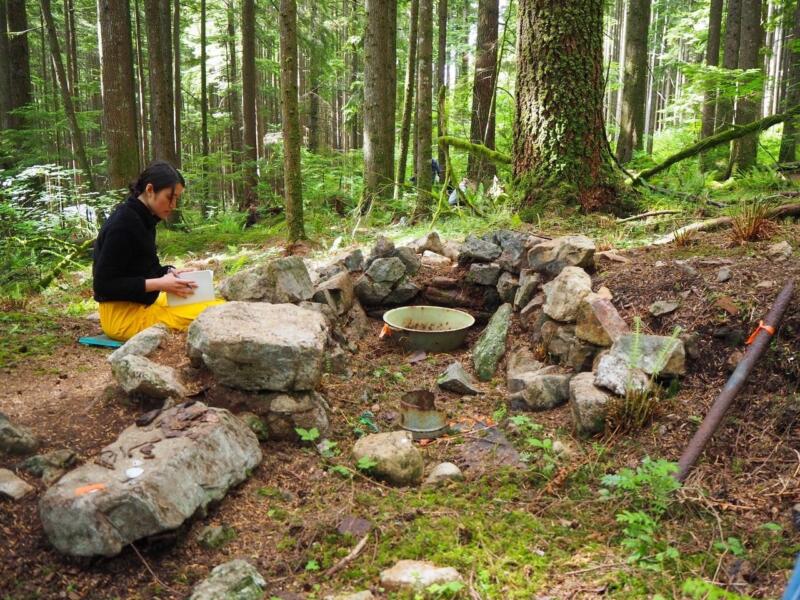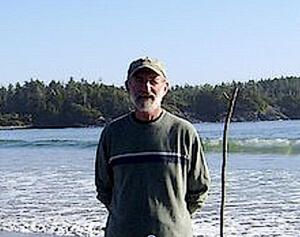1799 Secret of the North Shore woods
Forgotten Things: The Story of the Seymour Valley Archaeology Project
by Robert J. Muckle
Toronto: University of Toronto Press, 2022
$24.95 / 9781487588526
Reviewed by Daniel Francis
*
 During the decades between the two world wars a small number of Nikkei (i.e. Japanese-Canadian) loggers lived with their families deep in the woods on the North Shore of Burrard Inlet in what is now the Seymour Demonstration Forest. Originally the men worked for a logging outfit owned by entrepreneur Eikichi Kagetsu. When that operation closed in the mid-1920s, the Nikkei stayed on. Their hidden village of perhaps fifty people consisted of about fourteen cabins, a bathhouse or ofuro, a garden, a water reservoir, a privy and possibly a shrine. The people were isolated but they were not cut off from the wider world. The men might easily have walked to the nearest streetcar stop at the top of Lynn Valley Road and commuted to jobs in the urban centre, returning to their families each evening. This went on until 1942 when all the Nikkei living on or near the BC coast were removed to camps in the interior or across Canada and the forest began its reclamation of their homes.
During the decades between the two world wars a small number of Nikkei (i.e. Japanese-Canadian) loggers lived with their families deep in the woods on the North Shore of Burrard Inlet in what is now the Seymour Demonstration Forest. Originally the men worked for a logging outfit owned by entrepreneur Eikichi Kagetsu. When that operation closed in the mid-1920s, the Nikkei stayed on. Their hidden village of perhaps fifty people consisted of about fourteen cabins, a bathhouse or ofuro, a garden, a water reservoir, a privy and possibly a shrine. The people were isolated but they were not cut off from the wider world. The men might easily have walked to the nearest streetcar stop at the top of Lynn Valley Road and commuted to jobs in the urban centre, returning to their families each evening. This went on until 1942 when all the Nikkei living on or near the BC coast were removed to camps in the interior or across Canada and the forest began its reclamation of their homes.
The history of this hidden village might never have been recovered if it was not for the work of Bob Muckle and successive teams of undergraduates enrolled in his archaeology workshop at Capilano University. The origins of these efforts date back to a morning in 1999 when an educational programmer organizing a summer camp in North Vancouver put in a cold call to the university looking for someone to teach kids how to use metal detectors to find stuff. Muckle, an archaeologist at the university, was the person who answered the phone. He agreed to meet with the caller and before the day was over the Seymour Valley Archaeology Project had been hatched. What happened next is the subject of Professor Muckle’s engaging book, Forgotten Things, the first in a new series of books about archaeology from the University of Toronto Press.

The Seymour River is one of many rivers and creeks that tumble down the slopes of the North Shore mountains to empty into Burrard Inlet. The river was dammed several decades ago and the reservoir now provides about forty percent of Vancouver’s water supply. The Valley has been used by Indigenous people for thousands of years and much more recently it was home to a small number of early settlers, miners and loggers. These scattered buildings formed the initial focus of the student archaeologists, along with one or two logging sites. But once they honed in on the Nikkei settlement, dubbed the McKenzie Creek site, it became the focus of the project.
We usually think of archaeology as dealing with the ancient past, unearthing artifacts and sites that long predate the arrival of Europeans in North America. And much of it does. But as Professor Muckle explains, the SVAP is an example of historical archaeology, the study of post-contact sites dating from a more recent period when written records also exist. At the most obvious level Forgotten Things is a primer in how to organize and carry out such an archaeological field study. To this end there is a lot of logistical detail that the average reader might find extraneous: how to lay out a site; how to document information; how to handle artifacts; the ethics of fieldwork; and so on. There are even useful sections on working in the rain and sharing the woods with bears. As Muckle admits, the primary readership will be students and their instructors. But there is also plenty for the general reader with any interest at all in the history of the North Shore or more generally in the study of archaeology.

The field school he organized ran between 2000 and 2019 for a total of fourteen seasons. During that time more than two hundred students took part in the program. They excavated several sites related to settlement and logging, all of which are discussed in the book, but the most interesting to the general reader is the surprising find of the hidden camp. The students recovered some 1000 items from the dig, including rice bowls, sake bottles and fragments of all sorts of ceramic items as well as coins and pieces of metal objects such as lanterns and stoves. Some of these artifacts now reside in the collections of the Museum of North Vancouver and the Nikkei National Museum & Cultural Centre in Burnaby.

Of course the context for this settlement was the anti-Asian racism which permeated Vancouver society before the Second World War. Japanese (and Chinese) residents could not vote. They could not enter most professions, or live in many parts of Vancouver. The most extreme expression of this racism was the 1907 anti-Asian “riot” when white mobs stormed Chinatown and the Powell Street area smashing property and assaulting residents. But anti-Asian discrimination continued to fester in the city for decades, evident in regulations limiting Asian immigration and racist laws of various kinds. In this climate it was no surprise that a group of Nikkei might find it an attractive alternative to live in an isolated settlement in the North Shore woods.
Forgotten Things is just part of the public education component of the SVAP. Indeed, one of the objectives of the project was “to amplify the value of archaeology to the public.” Professor Muckle regularly made the site available to school and community groups for tours, hosted workshops, gave lectures and reached out to the media. I was lucky enough to attend one of his information sessions and found him to be an entertaining speaker who was well able to convey the significance and interest of the project to a non-academic audience. The same goes for his book.

*

Daniel Francis is the author of thirty books, principally about Canadian and BC history. His latest is the bestselling Becoming Vancouver: A History (2021), reviewed by Patricia Roy, and a previous book, Where Mountains Meet The Sea: an Illustrated History of the District of North Vancouver (2016), was reviewed by Trevor Carolan. Editor’s note: Daniel Francis has also reviewed books by Stephen R. Bown, Martha Black, Lorne Hammond, & Gavin Hanke, Peter Neary & Alan Collier, and Ben Bradley. He lives in North Vancouver. Visit his website here.
*
The British Columbia Review
Interim Editors, 2023-24: Trevor Marc Hughes (non-fiction), Brett Josef Grubisic (fiction)
Publisher: Richard Mackie
Formerly The Ormsby Review, The British Columbia Review is an on-line book review and journal service for BC writers and readers. The Advisory Board consists of Jean Barman, Wade Davis, Robin Fisher, Barry Gough, Hugh Johnston, Kathy Mezei, Patricia Roy, Maria Tippett, and Graeme Wynn. Provincial Government Patron (since September 2018): Creative BC. Honorary Patron: Yosef Wosk. Scholarly Patron: SFU Graduate Liberal Studies.
“Only connect.” – E.M. Forster
One comment on “1799 Secret of the North Shore woods”